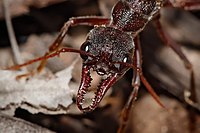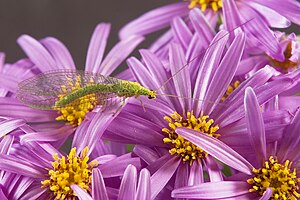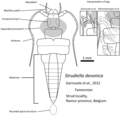Portal:Insects
The Insects Portal


Insects (from Latin insectum) are hexapod invertebrates of the class Insecta. They are the largest group within the arthropod phylum. Insects have a chitinous exoskeleton, a three-part body (head, thorax and abdomen), three pairs of jointed legs, compound eyes, and a pair of antennae. Insects are the most diverse group of animals, with more than a million described species; they represent more than half of all animal species. (Full article...)
Selected article -
Did you know -
- ... that the golden-green carpenter bee defends its nesting burrow by blocking the entrance with its abdomen?
- ... that caterpillars of the oak leafroller and oak leaftier moths are major defoliators of oak trees, with leafroller timber losses in Pennsylvania of over $100,000,000 in the early 1970s?
- ... that Nanoraphidia electroburmica, known from a fossil in amber, is the smallest known snakefly species, living or extinct?
- ... that researchers finally collected a larva and an adult female Tonyosynthemis ofarrelli which match an earlier male specimen?
- ... that the common spangle gall on the leaves of pedunculate oak trees is produced by the gall wasp Neurotus quercus-baccarum?
List articles
Related portals
General images -
Selected image -

Green lacewings (Neuroptera: Chrysopidae) is a family of lacewings containing about 85 genera and (according to different sources) 1,300–2,000 species. Members of the genera Chrysopa (pictured) and Chrysoperla are very common in North America and Europe; they are very similar and many of their species have been moved from one genus to the other times and again.
WikiProjects

Main WikiProject:
Related projects:
- WikiProject Arthropods
- WikiProject Spiders
- WikiProject Animals
- WikiProject Tree of Life
- WikiProject Biology
Daughter projects:
Tasks
 |
Here are some tasks awaiting attention:
|
Associated Wikimedia
The following Wikimedia Foundation sister projects provide more on this subject:
-
Commons
Free media repository -
Wikibooks
Free textbooks and manuals -
Wikidata
Free knowledge base -
Wikinews
Free-content news -
Wikiquote
Collection of quotations -
Wikisource
Free-content library -
Wikiversity
Free learning tools -
Wiktionary
Dictionary and thesaurus




















































